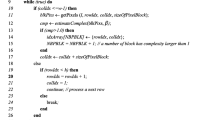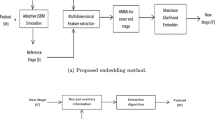Abstract
The computational complexity of matrix embedding (ME)-based steganography is high due to the use of the Hamming parity check matrix and matrix multiplication. Furthermore, with only one embedding change solution, ME cannot minimize embedding distortions when applied to joint photographic experts group (JPEG) steganography. In this paper, we propose a novel block data-hiding (BDH) algorithm to improve the performance of JPEG steganography. BDH allows a byte of data to be hidden in a binary block by modifying a maximum of two bits of the binary block must be changed. Moreover, BDH can be applied to the new channel selection rule for JPEG steganography with more available embedding solutions and less computational complexity than modified matrix embedding (MME). In addition, to increase the security of hidden data against extraction attacks, the secret message is encrypted by a cipher based on cellular automata (CA). The bitwise XOR operator is employed in the encryption process to maintain speed and security when a non-repeating key stream is used. The experimental results indicate that the proposed approach has a high anti-detection property against ensemble classifiers (universal steganalyzers), high security against recovery attacks, and good perceptual quality.




Similar content being viewed by others
References
Adamatzky A (2010) Game of life cellular automata. Springer, London. doi:10.1007/978-1-84996-217-9
Bandyopadhyay SK, Datta B (2011) Higher LSB layer based audio steganography technique. Int J Electron Commun Technol 2(4):129–135
Bridge S (2012) Chaos based encryption. codeproject. http://www.codeproject.com/Articles/311809/Chaos-Based-Encryption
Brown RG (2004) Dieharder a random number test suite. http://www.phy.duke.edu/~rgb/General/dieharder.php
Chao W, Weiming Z, Jiufen L, Nenghai Y (2012) Fast matrix embedding by matrix extending. IEEE Trans Inf Forensic Secur 7(1):346–350. doi:10.1109/tifs.2011.2164907
Chunhua C, Shi YQ JPEG image steganalysis utilizing both intrablock and interblock correlations. In: Circuits and Systems, 2008. ISCAS 2008. IEEE International Symposium on, 18–21 May 2008. pp 3029–3032. doi:10.1109/iscas.2008.4542096
Crandall R (1998) Some notes on steganography. http://www.dia.unisa.it/~ads/corso-security/www/CORSO-0203/steganografia/LINKS%20LOCALI/matrix-encoding.pdf
Cvejic N, Seppänen T (2005) Increasing robustness of LSB audio steganography by reduced distortion LSB coding. J Univ Comput Sci 11(1):56–65. doi:10.3217/jucs-011-01-0056
Fangjun H, Jiwu H, Yun-Qing S (2012) New channel selection rule for JPEG steganography. IEEE Trans Inf Forensic Secur 7(4):1181–1191. doi:10.1109/tifs.2012.2198213
Fridrich J, Goljan M, Soukal D Perturbed Quantization Steganography with Wet Paper Codes. In: ACM Multimedia and Security Workshop, Magdeburg, Germany, 2004. ACM New York, NY, USA, pp 4–15. doi:10.1145/1022431.1022435
Fridrich J, Tomás, Pevný, Kodovský J (2007) Statistically undetectable jpeg steganography: dead ends challenges, and opportunities. Paper presented at the Proceedings of the 9th workshop on Multimedia & security, Dallas, Texas, USA
Kim Y, Duric Z, Richards D (2007) Modified matrix encoding technique for minimal distortion steganography. In: Camenisch J, Collberg C, Johnson N, Sallee P (eds) Information hiding, vol 4437. Lecture notes in computer science. Springer Berlin, Heidelberg, pp 314–327. doi:10.1007/978-3-540-74124-4_21
Kodovský J, Fridrich J (2009) Calibration revisited. Paper presented at the Proceedings of the 11th ACM workshop on Multimedia and security, Princeton, New Jersey, USA
Kodovsky J, Fridrich J, Holub V (2012) Ensemble classifiers for steganalysis of digital media. IEEE Trans Inf Forensic Secur 7(2):432–444. doi:10.1109/tifs.2011.2175919
Langelaar GC, Setyawan I, Lagendijk RL (2000) Watermarking digital image and video data. A state-of-the-art overview. IEEE Signal Proc Mag 17(5):20–46. doi:10.1109/79.879337
Luo W, Huang F, Huang J (2011) A more secure steganography based on adaptive pixel-value differencing scheme. Multimed Tools Appl 52(2–3):407–430. doi:10.1007/s11042-009-0440-3
Mazurczyk W, Szaga P, Szczypiorski K (2012) Using transcoding for hidden communication in IP telephony. Multimed Tools Appl:1–27. doi:10.1007/s11042-012-1224-8
Never-compressed image database (2011) Sam Houston State University. http://www.shsu.edu/~qxl005/New/Downloads/index.html
Omoomi M, Samavi S, Dumitrescu S (2011) An efficient high payload ±1 data embedding scheme. Multimed Tools Appl 54(2):201–218. doi:10.1007/s11042-010-0517-z
Pevny T, Fridrich J Merging Markov and DCT Features for Multi-Class JPEG Steganalysis. In: Delp EJ, Wong PW (eds) Proceedings SPIE, Electronic Imaging, Security, Steganography and Watermarking of Multimedia Contents IX, San Jose, CA, 2007. pp 301–314
Qazanfari K, Safabakhsh R (2013) High-capacity method for hiding data in the discrete cosine transform domain. ELECTIM 22(4):043009–043009. doi:10.1117/1.jei.22.4.043009
Sallee P (2004) Model-based steganography. In: Kalker T, Cox I, Ro Y (eds) Digital watermarking, vol 2939. Lecture notes in computer science. Springer, Berlin, pp 154–167. doi:10.1007/978-3-540-24624-4_12
Sarkar A, Madhow U, Manjunath BS (2010) Matrix embedding with pseudorandom coefficient selection and error correction for robust and secure steganography. IEEE Trans Inf Forensic Secur 5(2):225–239. doi:10.1109/tifs.2010.2046218
Solanki K, Sarkar A, Manjunath BS (2007) YASS: yet another steganographic scheme that resists blind steganalysis. Paper presented at the Proceedings of the 9th international conference on Information hiding, Saint Malo, France
Su P-C, Lu M-T, Wu C-Y (2013) A practical design of high-volume steganography in digital video files. Multimed Tools Appl 66(2):247–266. doi:10.1007/s11042-011-0799-9
Westfeld A High capacity despite better steganalysis (F5-A steganographic algorithm). In: Moskowitz IS (ed) 4th International Workshop on Information Hiding, Pittsburgh, USA, 2001. Springer-Verlag, pp 289–302. doi:http://citeseerx.ist.psu.edu/viewdoc/download?doi=10.1.1.115.3651
Author information
Authors and Affiliations
Corresponding author
Rights and permissions
About this article
Cite this article
Nguyen, T.D., Arch-int, S. & Arch-int, N. A novel secure block data-hiding algorithm using cellular automata to enhance the performance of JPEG steganography. Multimed Tools Appl 74, 5661–5682 (2015). https://doi.org/10.1007/s11042-014-1877-6
Published:
Issue Date:
DOI: https://doi.org/10.1007/s11042-014-1877-6




